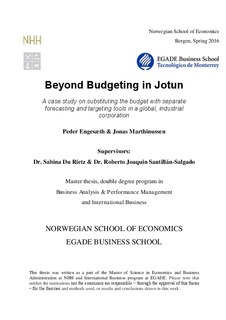Beyond budgeting in Jotun : a case study on substituting the budget with separate forecasting and targeting tools in a global, industrial corporation
Master thesis
Permanent lenke
http://hdl.handle.net/11250/2403715Utgivelsesdato
2016-09-02Metadata
Vis full innførselSamlinger
- Master Thesis [4372]
Sammendrag
The following thesis is a qualitative study aimed at contributing to the Beyond Budgeting
literature on unbundling the traditional budget by answering the question:
“Why may global, industrial corporations attempting to go Beyond Budgeting struggle to
effectively substitute the budget with separate forecasting and targeting functions?”
We find this research problem interesting, as there are no case studies today documenting
potential struggles of separating the forecasting and targeting functions. The aim is to fill this
gap in this literature by providing insight into the process and struggles inherent in this
separation process.
As the basis to answer this question, we have performed a case study on Jotun, a global
chemicals company originally from Norway. Jotun introduced a targeting tool called Strategic
Target Planning (STP) in 2007, and have in parallel attempted to make what they call cost
budget into a forecasting tool.
Beyond Budgeting literature proposes several reasons for separating the traditional budget into
individual processes, such as decreased resource use due to less negotiation, more flexibility
because of more autonomy, and less gaming as there are fewer conflicting purposes.
In this case study we found that Jotun has only partially managed to remedy these issues by
substituting the budget with separate forecasting and targeting tools. One interesting finding
that has not been addressed in previous literature is the paradox of autonomy. If an
organization already has a culture based on the decentralization and trust that is necessary for
Beyond Budgeting to function well, this culture can be counter-productive to the
implementation of Beyond Budgeting in the first place. We also found evidence that
separating the forecasting and targeting function from the traditional budget could still lead
to skewed incentives and gaming, as these new tools can still be misinterpreted or involve
conflicting purposes, such as resource allocation, benchmarking and bonus schemes. A third
finding was that the substitution of the budget with separate forecasting and targeting tools
may lead to more flexibility in terms of upwards spending, but not as much downwards. This
implies that spending in excess of the forecast is possible as long as the business case is
good, but that there is less flexibility in reducing costs when actual needs turn out to be less
than forecasted as employees perceive the funds to be allocated already.
